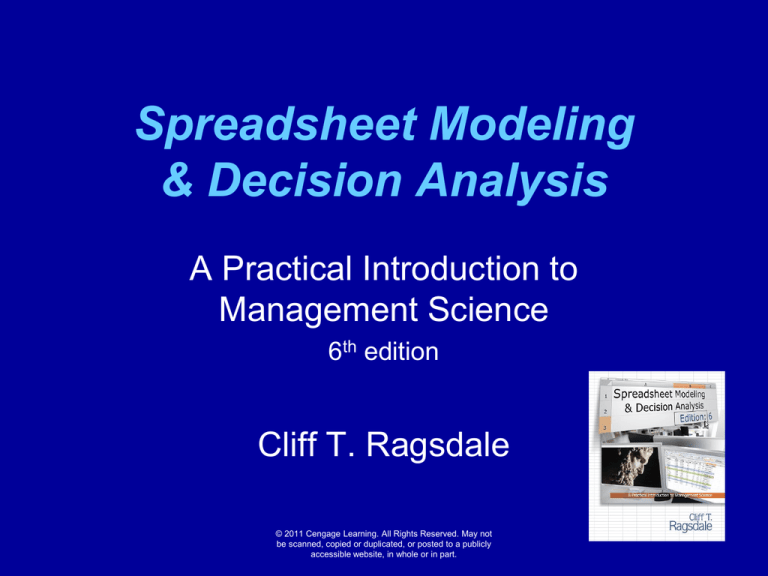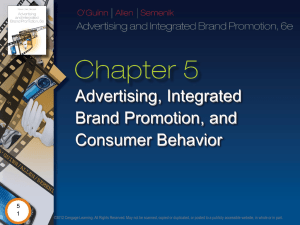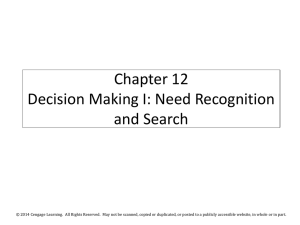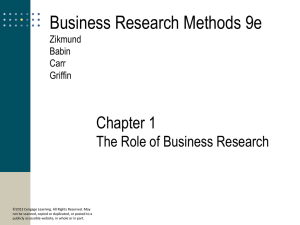
Spreadsheet Modeling
& Decision Analysis
A Practical Introduction to
Management Science
6th edition
Cliff T. Ragsdale
© 2011 Cengage Learning. All Rights Reserved. May not
be scanned, copied or duplicated, or posted to a publicly
accessible website, in whole or in part.
Chapter 3
Modeling and Solving LP
Problems in a Spreadsheet
© 2011 Cengage Learning. All Rights Reserved. May not
be scanned, copied or duplicated, or posted to a publicly
accessible website, in whole or in part.
Introduction
Solving LP problems graphically is only
possible when there are two decision
variables
Few real-world LP have only two decision
variables
Fortunately, we can now use
spreadsheets to solve LP problems
© 2011 Cengage Learning. All Rights Reserved. May not
be scanned, copied or duplicated, or posted to a publicly
accessible website, in whole or in part.
Spreadsheet Solvers
The company that makes the Solver in
Excel, Lotus 1-2-3, and Quattro Pro is
Frontline Systems, Inc.
Check out their web site:
http://www.solver.com
Other packages for solving MP problems:
AMPL
CPLEX
LINDO
MPSX
© 2011 Cengage Learning. All Rights Reserved. May not
be scanned, copied or duplicated, or posted to a publicly
accessible website, in whole or in part.
Risk Solver Platform
This book comes with a 140-day trial
version of Risk Solver Platform (RSP)
RSP includes:
– a greatly enhanced version of the Solver built
into Excel
– and many other tools & features to be
discussed throughout this book
You can download RSP from:
http://www.solver.com/student
© 2011 Cengage Learning. All Rights Reserved. May not
be scanned, copied or duplicated, or posted to a publicly
accessible website, in whole or in part.
The Steps in Implementing an
LP Model in a Spreadsheet
1. Organize the data for the model on the
spreadsheet.
2. Reserve separate cells in the spreadsheet for
each decision variable in the model.
3. Create a formula in a cell in the spreadsheet
that corresponds to the objective function.
4. For each constraint, create a formula in a
separate cell in the spreadsheet that
corresponds to the left-hand side (LHS) of the
constraint.
© 2011 Cengage Learning. All Rights Reserved. May not
be scanned, copied or duplicated, or posted to a publicly
accessible website, in whole or in part.
Let’s Implement a Model for the
Blue Ridge Hot Tubs Example...
MAX: 350X1 + 300X2
S.T.: 1X1 + 1X2 <= 200
9X1 + 6X2 <= 1566
12X1 + 16X2 <= 2880
X1, X2 >= 0
© 2011 Cengage Learning. All Rights Reserved. May not
be scanned, copied or duplicated, or posted to a publicly
accessible website, in whole or in part.
} profit
} pumps
} labor
} tubing
} nonnegativity
Implementing the Model
See file Fig3-1.xlsm
© 2011 Cengage Learning. All Rights Reserved. May not
be scanned, copied or duplicated, or posted to a publicly
accessible website, in whole or in part.
How Solver Views the Model
Objective cell - the cell in the spreadsheet
that represents the objective function
Variable cells - the cells in the spreadsheet
representing the decision variables
Constraint cells - the cells in the
spreadsheet representing the LHS formulas
on the constraints
© 2011 Cengage Learning. All Rights Reserved. May not
be scanned, copied or duplicated, or posted to a publicly
accessible website, in whole or in part.
Let’s go back to Excel and see
how “Solver” works...
© 2011 Cengage Learning. All Rights Reserved. May not
be scanned, copied or duplicated, or posted to a publicly
accessible website, in whole or in part.
Goals For Spreadsheet Design
Communication - A spreadsheet's primary business
purpose is communicating information to managers.
Reliability - The output a spreadsheet generates
should be correct and consistent.
Auditability - A manager should be able to retrace the
steps followed to generate the different outputs from the
model in order to understand and verify results.
Modifiability - A well-designed spreadsheet should
be easy to change or enhance in order to meet dynamic
user requirements.
© 2011 Cengage Learning. All Rights Reserved. May not
be scanned, copied or duplicated, or posted to a publicly
accessible website, in whole or in part.
Spreadsheet Design
Guidelines - I
Organize the data, then build the model
around the data.
Do not embed numeric constants in
formulas.
Things which are logically related should
be physically related.
Use formulas that can be copied.
Column/rows totals should be close to the
columns/rows being totaled.
© 2011 Cengage Learning. All Rights Reserved. May not
be scanned, copied or duplicated, or posted to a publicly
accessible website, in whole or in part.
Spreadsheet Design
Guidelines - II
The English-reading eye scans left to right,
top to bottom.
Use color, shading, borders and protection
to distinguish changeable parameters from
other model elements.
Use text boxes and cell notes to document
various elements of the model.
© 2011 Cengage Learning. All Rights Reserved. May not
be scanned, copied or duplicated, or posted to a publicly
accessible website, in whole or in part.
Make vs. Buy Decisions:
The Electro-Poly Corporation
Electro-Poly is a leading maker of slip-rings.
A $750,000 order has just been received.
Model 1
Model 2
Model 3
3,000
2,000
900
Hours of wiring/unit
2
1.5
3
Hours of harnessing/unit
1
2
1
Cost to Make
$50
$83
$130
Cost to Buy
$61
$97
$145
Number ordered
The company has 10,000 hours of wiring
capacity and 5,000 hours of harnessing capacity.
© 2011 Cengage Learning. All Rights Reserved. May not
be scanned, copied or duplicated, or posted to a publicly
accessible website, in whole or in part.
Defining the Decision Variables
M1 = Number of model 1 slip rings to make in-house
M2 = Number of model 2 slip rings to make in-house
M3 = Number of model 3 slip rings to make in-house
B1 = Number of model 1 slip rings to buy from competitor
B2 = Number of model 2 slip rings to buy from competitor
B3 = Number of model 3 slip rings to buy from competitor
© 2011 Cengage Learning. All Rights Reserved. May not
be scanned, copied or duplicated, or posted to a publicly
accessible website, in whole or in part.
Defining the Objective Function
Minimize the total cost of filling the order.
MIN: 50M1+ 83M2+ 130M3+ 61B1+ 97B2+ 145B3
© 2011 Cengage Learning. All Rights Reserved. May not
be scanned, copied or duplicated, or posted to a publicly
accessible website, in whole or in part.
Defining the Constraints
Demand Constraints
M1 + B1 = 3,000 } model 1
M2 + B2 = 2,000 } model 2
M3 + B3 =
900 } model 3
Resource Constraints
2M1 + 1.5M2 + 3M3 <= 10,000 } wiring
1M1 + 2.0M2 + 1M3 <= 5,000 } harnessing
Nonnegativity Conditions
M1, M2, M3, B1, B2, B3 >= 0
© 2011 Cengage Learning. All Rights Reserved. May not
be scanned, copied or duplicated, or posted to a publicly
accessible website, in whole or in part.
Implementing the Model
See file Fig3-19.xlsm
© 2011 Cengage Learning. All Rights Reserved. May not
be scanned, copied or duplicated, or posted to a publicly
accessible website, in whole or in part.
An Investment Problem:
Retirement Planning Services, Inc.
A client wishes to invest $750,000 in the
following bonds.
Company
Return
Years to
Maturity
Acme Chemical
8.65%
11
1-Excellent
DynaStar
9.50%
10
3-Good
Eagle Vision
10.00%
6
4-Fair
Micro Modeling
8.75%
10
1-Excellent
OptiPro
9.25%
7
3-Good
Sabre Systems
9.00%
13
2-Very Good
© 2011 Cengage Learning. All Rights Reserved. May not
be scanned, copied or duplicated, or posted to a publicly
accessible website, in whole or in part.
Rating
Investment Restrictions
No more than 25% can be invested in any
single company.
At least 50% should be invested in longterm bonds (maturing in 10+ years).
No more than 35% can be invested in
DynaStar, Eagle Vision, and OptiPro.
© 2011 Cengage Learning. All Rights Reserved. May not
be scanned, copied or duplicated, or posted to a publicly
accessible website, in whole or in part.
Defining the Decision Variables
X1 = amount of money to invest in Acme Chemical
X2 = amount of money to invest in DynaStar
X3 = amount of money to invest in Eagle Vision
X4 = amount of money to invest in MicroModeling
X5 = amount of money to invest in OptiPro
X6 = amount of money to invest in Sabre Systems
© 2011 Cengage Learning. All Rights Reserved. May not
be scanned, copied or duplicated, or posted to a publicly
accessible website, in whole or in part.
Defining the Objective Function
Maximize the total
annual investment return:
MAX: .0865X1+ .095X2+ .10X3+ .0875X4+ .0925X5+ .09X6
© 2011 Cengage Learning. All Rights Reserved. May not
be scanned, copied or duplicated, or posted to a publicly
accessible website, in whole or in part.
Defining the Constraints
Total amount is invested
X1 + X2 + X3 + X4 + X5 + X6 = 750,000
No more than 25% in any one investment
Xi <= 187,500, for all i
50% long term investment restriction.
X1 + X2 + X4 + X6 >= 375,000
35% Restriction on DynaStar, Eagle Vision, and
OptiPro.
X2 + X3 + X5 <= 262,500
Nonnegativity conditions
Xi >= 0 for all i
© 2011 Cengage Learning. All Rights Reserved. May not
be scanned, copied or duplicated, or posted to a publicly
accessible website, in whole or in part.
Implementing the Model
See file Fig3-22.xlsm
© 2011 Cengage Learning. All Rights Reserved. May not
be scanned, copied or duplicated, or posted to a publicly
accessible website, in whole or in part.
A Transportation Problem:
Tropicsun
Supply
Groves
Distances (in miles)
Capacity
21
Mt. Dora
275,000
Processing
Plants
1
50
Ocala
4
200,000
40
35
400,000
30
Eustis
2
Orlando
600,000
5
22
55
20
Clermont
300,000
3
25
© 2011 Cengage Learning. All Rights Reserved. May not
be scanned, copied or duplicated, or posted to a publicly
accessible website, in whole or in part.
Leesburg
6
225,000
Defining the Decision
Variables
Xij = # of bushels shipped from node i to node j
Specifically, the nine decision variables are:
X14 = # of bushels shipped from Mt. Dora (node 1) to Ocala (node 4)
X15 = # of bushels shipped from Mt. Dora (node 1) to Orlando (node 5)
X16 = # of bushels shipped from Mt. Dora (node 1) to Leesburg (node 6)
X24 = # of bushels shipped from Eustis (node 2) to Ocala (node 4)
X25 = # of bushels shipped from Eustis (node 2) to Orlando (node 5)
X26 = # of bushels shipped from Eustis (node 2) to Leesburg (node 6)
X34 = # of bushels shipped from Clermont (node 3) to Ocala (node 4)
X35 = # of bushels shipped from Clermont (node 3) to Orlando (node 5)
X36 = # of bushels shipped from Clermont (node 3) to Leesburg (node 6)
© 2011 Cengage Learning. All Rights Reserved. May not
be scanned, copied or duplicated, or posted to a publicly
accessible website, in whole or in part.
Defining the Objective Function
Minimize the total number of bushel-miles.
MIN: 21X14 + 50X15 + 40X16 +
35X24 + 30X25 + 22X26 +
55X34 + 20X35 + 25X36
© 2011 Cengage Learning. All Rights Reserved. May not
be scanned, copied or duplicated, or posted to a publicly
accessible website, in whole or in part.
Defining the Constraints
Capacity constraints
X14 + X24 + X34 <= 200,000
X15 + X25 + X35 <= 600,000
X16 + X26 + X36 <= 225,000
} Ocala
} Orlando
} Leesburg
Supply constraints
X14 + X15 + X16 = 275,000
X24 + X25 + X26 = 400,000
X34 + X35 + X36 = 300,000
} Mt. Dora
} Eustis
} Clermont
Nonnegativity conditions
Xij >= 0 for all i and j
© 2011 Cengage Learning. All Rights Reserved. May not
be scanned, copied or duplicated, or posted to a publicly
accessible website, in whole or in part.
Implementing the Model
See file Fig3-26.xlsm
© 2011 Cengage Learning. All Rights Reserved. May not
be scanned, copied or duplicated, or posted to a publicly
accessible website, in whole or in part.
A Blending Problem:
The Agri-Pro Company
Agri-Pro has received an order for 8,000 pounds of
chicken feed to be mixed from the following feeds.
Percent of Nutrient in
Nutrient
Feed 1
Feed 2
Feed 3
Feed 4
Corn
30%
5%
20%
10%
Grain
10%
3%
15%
10%
Minerals
20%
20%
20%
30%
Cost per pound
$0.25
$0.30
$0.32
$0.15
The order must contain at least 20% corn, 15%
grain, and 15% minerals.
© 2011 Cengage Learning. All Rights Reserved. May not
be scanned, copied or duplicated, or posted to a publicly
accessible website, in whole or in part.
Defining the Decision Variables
X1 = pounds of feed 1 to use in the mix
X2 = pounds of feed 2 to use in the mix
X3 = pounds of feed 3 to use in the mix
X4 = pounds of feed 4 to use in the mix
© 2011 Cengage Learning. All Rights Reserved. May not
be scanned, copied or duplicated, or posted to a publicly
accessible website, in whole or in part.
Defining the Objective Function
Minimize the total cost of filling the order.
MIN:
0.25X1 + 0.30X2 + 0.32X3 + 0.15X4
© 2011 Cengage Learning. All Rights Reserved. May not
be scanned, copied or duplicated, or posted to a publicly
accessible website, in whole or in part.
Defining the Constraints
Produce 8,000 pounds of feed
X1 + X2 + X3 + X4 = 8,000
Mix consists of at least 20% corn
(0.3X1 + 0.5X2 + 0.2X3 + 0.1X4)/8000 >= 0.2
Mix consists of at least 15% grain
(0.1X1 + 0.3X2 + 0.15X3 + 0.1X4)/8000 >= 0.15
Mix consists of at least 15% minerals
(0.2X1 + 0.2X2 + 0.2X3 + 0.3X4)/8000 >= 0.15
Nonnegativity conditions
X1, X2, X3, X4 >= 0
© 2011 Cengage Learning. All Rights Reserved. May not
be scanned, copied or duplicated, or posted to a publicly
accessible website, in whole or in part.
A Comment About Scaling
Notice the coefficient for X2 in the ‘corn’
constraint is 0.05/8000 = 0.00000625
As Solver runs, intermediate calculations are
made that make coefficients larger or smaller.
Storage problems may force the computer to
use approximations of the actual numbers.
Such ‘scaling’ problems sometimes prevents
Solver from being able to solve the problem
accurately.
Most problems can be formulated in a way to
minimize scaling errors...
© 2011 Cengage Learning. All Rights Reserved. May not
be scanned, copied or duplicated, or posted to a publicly
accessible website, in whole or in part.
Re-Defining the Decision
Variables
X1 = thousands of pounds of feed 1 to use in the mix
X2 = thousands of pounds of feed 2 to use in the mix
X3 = thousands of pounds of feed 3 to use in the mix
X4 = thousands of pounds of feed 4 to use in the mix
© 2011 Cengage Learning. All Rights Reserved. May not
be scanned, copied or duplicated, or posted to a publicly
accessible website, in whole or in part.
Re-Defining the
Objective Function
Minimize the total cost of filling the order.
MIN:
250X1 + 300X2 + 320X3 + 150X4
© 2011 Cengage Learning. All Rights Reserved. May not
be scanned, copied or duplicated, or posted to a publicly
accessible website, in whole or in part.
Re-Defining the Constraints
Produce 8,000 pounds of feed
X1 + X2 + X3 + X4 = 8
Mix consists of at least 20% corn
(0.3X1 + 0.5X2 + 0.2X3 + 0.1X4)/8 >= 0.2
Mix consists of at least 15% grain
(0.1X1 + 0.3X2 + 0.15X3 + 0.1X4)/8 >= 0.15
Mix consists of at least 15% minerals
(0.2X1 + 0.2X2 + 0.2X3 + 0.3X4)/8 >= 0.15
Nonnegativity conditions
X1, X2, X3, X4 >= 0
© 2011 Cengage Learning. All Rights Reserved. May not
be scanned, copied or duplicated, or posted to a publicly
accessible website, in whole or in part.
Scaling: Before and After
Before:
– Largest constraint coefficient was 8,000
– Smallest constraint coefficient was
0.05/8 = 0.00000625.
After:
– Largest constraint coefficient is 8
– Smallest constraint coefficient is
0.05/8 = 0.00625.
The problem is now more evenly scaled!
© 2011 Cengage Learning. All Rights Reserved. May not
be scanned, copied or duplicated, or posted to a publicly
accessible website, in whole or in part.
Implementing the Model
See file Fig3-30.xlsm
© 2011 Cengage Learning. All Rights Reserved. May not
be scanned, copied or duplicated, or posted to a publicly
accessible website, in whole or in part.
A Production Planning Problem:
The Upton Corporation
Upton is planning the production of their heavy-duty air
compressors for the next 6 months.
1
2
3
Unit Production Cost
$240
$250
Units Demanded
1,000
Maximum Production
Minimum Production
•
•
•
•
Month
4
5
6
$265
$285
$280
$260
4,500
6,000
5,500 3,500
4,000
4,000
3,500
4,000
4,500 4,000
3,500
2,000
1,750
2,000
2,250 2,000
1,750
Beginning inventory = 2,750 units
Safety stock = 1,500 units
Unit carrying cost = 1.5% of unit production cost
Maximum warehouse capacity = 6,000 units
© 2011 Cengage Learning. All Rights Reserved. May not
be scanned, copied or duplicated, or posted to a publicly
accessible website, in whole or in part.
Defining the Decision Variables
Pi = number of units to produce in month i, i=1 to 6
Bi = beginning inventory month i, i=1 to 6
© 2011 Cengage Learning. All Rights Reserved. May not
be scanned, copied or duplicated, or posted to a publicly
accessible website, in whole or in part.
Defining the Objective Function
Minimize the total cost production
& inventory costs.
MIN: 240P1+250P2+265P3+285P4+280P5+260P6
+ 3.6(B1+B2)/2 + 3.75(B2+B3)/2 + 3.98(B3+B4)/2
+ 4.28(B4+B5)/2 + 4.20(B5+ B6)/2 + 3.9(B6+B7)/2
Note: The beginning inventory in any month is the
same as the ending inventory in the previous month.
© 2011 Cengage Learning. All Rights Reserved. May not
be scanned, copied or duplicated, or posted to a publicly
accessible website, in whole or in part.
Defining the Constraints - I
Production levels
2,000 <= P1 <= 4,000 } month 1
1,750 <= P2 <= 3,500 } month 2
2,000 <= P3 <= 4,000 } month 3
2,250 <= P4 <= 4,500 } month 4
2,000 <= P5 <= 4,000 } month 5
1,750 <= P6 <= 3,500 } month 6
© 2011 Cengage Learning. All Rights Reserved. May not
be scanned, copied or duplicated, or posted to a publicly
accessible website, in whole or in part.
Defining the Constraints - II
Ending Inventory (EI = BI + P - D)
1,500 < B1 + P1 - 1,000 < 6,000 } month 1
1,500 < B2 + P2 - 4,500 < 6,000 } month 2
1,500 < B3 + P3 - 6,000 < 6,000 } month 3
1,500 < B4 + P4 - 5,500 < 6,000 } month 4
1,500 < B5 + P5 - 3,500 < 6,000 } month 5
1,500 < B6 + P6 - 4,000 < 6,000 } month 6
© 2011 Cengage Learning. All Rights Reserved. May not
be scanned, copied or duplicated, or posted to a publicly
accessible website, in whole or in part.
Defining the Constraints - III
Beginning Balances
B1 = 2750
B2 = B1 + P1 - 1,000
B3 = B2 + P2 - 4,500
B4 = B3 + P3 - 6,000
B5 = B4 + P4 - 5,500
B6 = B5 + P5 - 3,500
B7 = B6 + P6 - 4,000
© 2011 Cengage Learning. All Rights Reserved. May not
be scanned, copied or duplicated, or posted to a publicly
accessible website, in whole or in part.
Notice that the Bi
can be computed
directly from the
Pi. Therefore,
only the Pi need
to be identified
as changing
cells.
Implementing the Model
See file Fig3-33.xlsm
© 2011 Cengage Learning. All Rights Reserved. May not
be scanned, copied or duplicated, or posted to a publicly
accessible website, in whole or in part.
A Multi-Period Cash Flow
Problem:
The Taco-Viva Sinking Fund - I
Taco-Viva needs a sinking fund to pay $800,000 in
building costs for a new restaurant in the next 6 months.
Payments of $250,000 are due at the end of months 2
and 4, and a final payment of $300,000 is due at the end
of month 6.
The following investments may be used.
Investment
A
B
C
D
Available in Month Months to Maturity Yield at Maturity
1, 2, 3, 4, 5, 6
1
1.8%
1, 3, 5
2
3.5%
1, 4
3
5.8%
1
6
11.0%
© 2011 Cengage Learning. All Rights Reserved. May not
be scanned, copied or duplicated, or posted to a publicly
accessible website, in whole or in part.
Summary of Possible Cash Flows
Cash Inflow/Outflow at the Beginning of Month
Investment
1
2
3
4
5
6
7
A1
-1
1.018
B1
-1 <_____> 1.035
C1
-1 <_____> <_____> 1.058
D1
-1 <_____> <_____> <_____> <_____> <_____> 1.11
A2
-1
1.018
A3
-1
1.018
B3
-1 <_____> 1.035
A4
-1
1.018
C4
-1 <_____> <_____> 1.058
A5
-1
1.018
B5
-1 <_____> 1.035
A6
-1
1.018
Req’d Payments $0
$0
$250
$0
$250
$0
$300
(in $1,000s)
© 2011 Cengage Learning. All Rights Reserved. May not
be scanned, copied or duplicated, or posted to a publicly
accessible website, in whole or in part.
Defining the Decision Variables
Ai = amount (in $1,000s) placed in investment A at
the beginning of month i=1, 2, 3, 4, 5, 6
Bi = amount (in $1,000s) placed in investment B at
the beginning of month i=1, 3, 5
Ci = amount (in $1,000s) placed in investment C at
the beginning of month i=1, 4
Di = amount (in $1,000s) placed in investment D at
the beginning of month i=1
© 2011 Cengage Learning. All Rights Reserved. May not
be scanned, copied or duplicated, or posted to a publicly
accessible website, in whole or in part.
Defining the Objective Function
Minimize the total cash invested in month 1.
MIN: A1 + B1 + C1 + D1
© 2011 Cengage Learning. All Rights Reserved. May not
be scanned, copied or duplicated, or posted to a publicly
accessible website, in whole or in part.
Defining the Constraints
Cash Flow Constraints
1.018A1 – 1A2 = 0
} month 2
1.035B1 + 1.018A2 – 1A3 – 1B3 = 250 } month 3
1.058C1 + 1.018A3 – 1A4 – 1C4 = 0 } month 4
1.035B3 + 1.018A4 – 1A5 – 1B5 = 250 } month 5
1.018A5 –1A6 = 0
} month 6
1.11D1 + 1.058C4 + 1.035B5 + 1.018A6 = 300 } month 7
Nonnegativity Conditions
Ai, Bi, Ci, Di >= 0, for all i
© 2011 Cengage Learning. All Rights Reserved. May not
be scanned, copied or duplicated, or posted to a publicly
accessible website, in whole or in part.
Implementing the Model
See file Fig3-37.xlsm
© 2011 Cengage Learning. All Rights Reserved. May not
be scanned, copied or duplicated, or posted to a publicly
accessible website, in whole or in part.
Risk Management:
The Taco-Viva Sinking Fund - II
Assume the CFO has assigned the following risk ratings to
each investment on a scale from 1 to 10 (10 = max risk)
Investment
A
B
C
D
Risk Rating
1
3
8
6
The CFO wants the weighted average risk to not exceed 5.
© 2011 Cengage Learning. All Rights Reserved. May not
be scanned, copied or duplicated, or posted to a publicly
accessible website, in whole or in part.
Defining the Constraints
Risk Constraints
1A1 + 3B1 + 8C1 + 6D1
A1 + B1 + C1 + D1
1A2 + 3B1 + 8C1 + 6D1
A2 + B1 + C1 + D1
1A3 + 3B3 + 8C1 + 6D1
A3 + B3 + C1 + D1
1A4 + 3B3 + 8C4 + 6D1
A4 + B3 + C4 + D1
1A5 + 3B5 + 8C4 + 6D1
A5 + B5 + C4 + D1
1A6 + 3B5 + 8C4 + 6D1
A6 + B5 + C4 + D1
<5
} month 1
<5
} month 2
<5
} month 3
<5
} month 4
<5
} month 5
<5
} month 6
© 2011 Cengage Learning. All Rights Reserved. May not
be scanned, copied or duplicated, or posted to a publicly
accessible website, in whole or in part.
An Alternate Version of
the Risk Constraints
Equivalent Risk Constraints
-4A1 – 2B1 + 3C1 + 1D1 < 0 } month 1
-2B1 + 3C1 + 1D1 – 4A2 < 0 } month 2
3C1 + 1D1 – 4A3 – 2B3 < 0 } month 3
1D1 – 2B3 – 4A4 + 3C4 < 0 } month 4
1D1 + 3C4 – 4A5 – 2B5 < 0 } month 5
1D1 + 3C4 – 2B5 – 4A6 < 0 } month 6
© 2011 Cengage Learning. All Rights Reserved. May not
be scanned, copied or duplicated, or posted to a publicly
accessible website, in whole or in part.
Note that each
coefficient is equal
to the risk factor
for the investment
minus 5 (the max.
allowable
weighted average
risk).
Implementing the Model
See file Fig3-40.xlsm
© 2011 Cengage Learning. All Rights Reserved. May not
be scanned, copied or duplicated, or posted to a publicly
accessible website, in whole or in part.
Data Envelopment Analysis (DEA):
Steak & Burger
Steak & Burger needs to evaluate the performance
(efficiency) of 12 units.
Outputs for each unit (Oij) include measures of: Profit,
Customer Satisfaction, and Cleanliness
Inputs for each unit (Iij) include: Labor Hours, and Operating
Costs
The “Efficiency” of unit i is defined as follows:
nO
Oij w j
Weighted sum of unit i’s outputs
Weighted sum of unit i’s inputs
=
j 1
nI
I ij v j
j 1
© 2011 Cengage Learning. All Rights Reserved. May not
be scanned, copied or duplicated, or posted to a publicly
accessible website, in whole or in part.
Defining the Decision Variables
wj = weight assigned to output j
vj = weight assigned to input j
A separate LP is solved for each unit, allowing each
unit to select the best possible weights for itself.
© 2011 Cengage Learning. All Rights Reserved. May not
be scanned, copied or duplicated, or posted to a publicly
accessible website, in whole or in part.
Defining the Objective Function
Maximize the weighted output for unit i :
nO
MAX: Oij w j
j 1
© 2011 Cengage Learning. All Rights Reserved. May not
be scanned, copied or duplicated, or posted to a publicly
accessible website, in whole or in part.
Defining the Constraints
Efficiency cannot exceed 100% for any unit
nO
nI
j 1
j 1
Okj w j I kj v j , k 1 to the number of units
Sum of weighted inputs for unit i must equal 1
nI
I ij v j 1
j 1
Nonnegativity Conditions
wj, vj >= 0, for all j
© 2011 Cengage Learning. All Rights Reserved. May not
be scanned, copied or duplicated, or posted to a publicly
accessible website, in whole or in part.
Important Point
When using DEA, output variables should be
expressed on a scale where “more is better”
and input variables should be expressed on a
scale where “less is better”.
© 2011 Cengage Learning. All Rights Reserved. May not
be scanned, copied or duplicated, or posted to a publicly
accessible website, in whole or in part.
Implementing the Model
See file Fig3-43.xlsm
© 2011 Cengage Learning. All Rights Reserved. May not
be scanned, copied or duplicated, or posted to a publicly
accessible website, in whole or in part.
Psi Functions
Risk Solver Platform includes a number of
custom functions that all begin with the letters
“Psi” (short for polymorphic spreadsheet
interpreter)
When running multiple optimizations:
– PsiCurrentOpt( ) returns the integer index of the
current optimization
– PsiOptValue(cell, opt #) returns the optimal
value of the indicated cell for a particular
optimization (opt #)
© 2011 Cengage Learning. All Rights Reserved. May not
be scanned, copied or duplicated, or posted to a publicly
accessible website, in whole or in part.
Analyzing The Solution
See file Fig3-48.xlsm
© 2011 Cengage Learning. All Rights Reserved. May not
be scanned, copied or duplicated, or posted to a publicly
accessible website, in whole or in part.
End of Chapter 3
© 2011 Cengage Learning. All Rights Reserved. May not
be scanned, copied or duplicated, or posted to a publicly
accessible website, in whole or in part.
The Risk Solver Platform software
featured in this book is provided
by Frontline Systems.
http://www.solver.com
© 2011 Cengage Learning. All Rights Reserved. May not
be scanned, copied or duplicated, or posted to a publicly
accessible website, in whole or in part.








